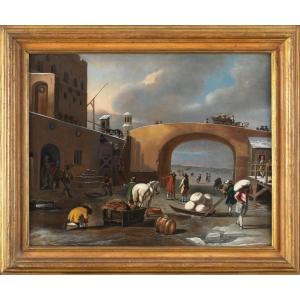This is the only painted portrait of the Chevalier de Guise, Roger de Lorraine. To date, only an engraving by Balthasar Moncornet (Brussels 1600 – Paris 1668) has carried his image to posterity (ill. 6). Our painting, kept until then at the Château d'Eu, comes from the collections of the Grande Mademoiselle then of King Louis-Philippe by descent.
Provenance:
- Anne Marie Louise d'Orléans (1627-1693), known as '"'La Grande Mademoiselle"", Duchess of Montpensier and cousin of King Louis XIV.
- Louis-Auguste de Bourbon (1670-1736), Duke of Maine , legitimized son of King Louis XIV and heir to the Grande Mademoiselle
- His son, Louis-Auguste de Bourbon (1700-1755), Prince of Dombes
- His brother, Louis-Charles de Bourbon (1701-1775), Count of
- His first cousin, Louis-Jean-Marie de Bourbon (1725-1793), Duke of Penthièvre
- His daughter, Marie-Adélaïde de Bourbon-Penthièvre (1753-1821), Duchess of Orléans
- His son , Louis-Philippe d'Orléans (1773-1850), Duke of Orléans then King of the French
- His son, Louis d'Orléans (1814-1896), Duke of Nemours
- His son, Ferdinand d'Orléans (1844 -1910), Duke of Alençon.
- Then by descent.
Our portrait is presented in an exceptional carved and gilded oak frame from the Louis XIV period with a brass cartel bearing the inscription: Roger de Lorraine - Chevalier de Guise - 1624- 1653. Two cache ets of wax on the back.
Dimensions: 64 x 54 cm - 85 x 74 cm with the frame
Stencil inscriptions on the canvas on the back: CM for Collection Montpensier (Anne Marie Louise d'Orléans Duchess of Montpensier (1627-1693) known as "La Grande Mademoiselle") and "Roger de Lorraine / Chevalier de Guise, last son of Charles de Lorraine, Duke of Guise and Joyeuse and Henriette-Catherine Duchess of Joyeuse, Montpensier and Guise. Born March 21, 1624. Died in Cambrai September 6, 1653 ."
Louis Ferdinand Elle, known as Elle the Father or Ferdinand II (Paris 19.07.1612 – Id. 12.12.1689), is the son of Ferdinand Elle the Elder (1585-1637) born in Mechelen, painter and engraver who worked in Paris as painter of portraits at the court of Louis XIII. Trained by his father, Louis Ferdinand perpetuated the Flemish tradition of portraiture; his elegantly posed characters bear witness to a clear influence of Van Dyck. Louis Ferdinand She shares with the Beaubruns the commissions for the portraits of the Precious circles, transforming her models into deities, such as the Lady as Minerva (Grobet-Labadié museum, Marseille). A member of the Royal Academy of Painting and Sculpture, he held the position of professor there until 1681, when he was expelled as a Protestant; he will be reinstated after his abjuration five years later. His son Louis Ferdinand Elle le Jeune (1648 – 1717) pursued the same path.
Roger de Lorraine (1624-1653), Knight of Guise, was a member of the House of Guise, the younger and French branch of the House of Lorraine. As such, the court of France gives him the honors due to the members of the reigning Houses. Youngest of the sons of Charles I of Lorraine, Duke of Guise, Count of Eu, and Henriette-Catherine de Joyeuse, Lady of Joinville, he spent several years of his childhood in Florence, after his father had exiled there by the Cardinal de Richelieu in 1631. The Grand Duchess of Tuscany, Christine de Lorraine, daughter of Duke Charles III of Lorraine and Claude de France, is one of his relatives. Very young, he was made a Knight of Malta and in 1644, he served at the siege of Gravelines. In March 1646, returning from a stay in Tuscany, he brought Jean-Baptiste Lully back to his niece, Mademoiselle de Montpensier “La Grande Mademoiselle”. On September 10, 1649, command of the Abbey of Eu was given to Charles-Maurice Le Tellier, Louvois' brother. But Roger de Lorraine caused a stir with Cardinal Mazarin who had promised it to him, forcing Le Tellier to resign before he even took possession of it. Now on bad terms with Mazarin, he left to serve his cousin, Duke Charles IV of Lorraine, who entrusted him with the command of his troops during the Campaign of 1653. In his thirtieth year, he was killed at the siege of Cambrai on 6 September 1653.
The Château d'Eu and its collection of historical portraits of the House of Guise: In the 17th century, after the death of Catherine de Clèves (+1633), the county of Eu fell to the Joyeuse family. In 1656, on the death of Henriette Catherine de Joyeuse (1585-1656), it was her granddaughter, Anne Marie Louise d'Orléans (1627-1693), Duchess of Montpensier "La Grande Mademoiselle" who inherited the county of 'Eu and his castle. The latter having participated in the Fronde against her royal cousin Louis XIV, she was exiled from the Court of France and it was in Eu, in Normandy, that she took refuge after leaving the castle of Saint Germain. The Princess immediately fell in love with the Château d'Eu and stayed there frequently during her years of exile, receiving her lover the Duke of Lauzun there, as her Memoirs confirm. La Grande Mademoiselle played a decisive role in the future of the building, which she made a royal castle. She ordered major developments there, including the creation of a terraced garden, à la Française, and the first park, the walls of which still remain. This is without mentioning his collection of historical paintings of the princes of the House of Guise, of which this portrait was a part.

























 Le Magazine de PROANTIC
Le Magazine de PROANTIC TRÉSORS Magazine
TRÉSORS Magazine Rivista Artiquariato
Rivista Artiquariato
